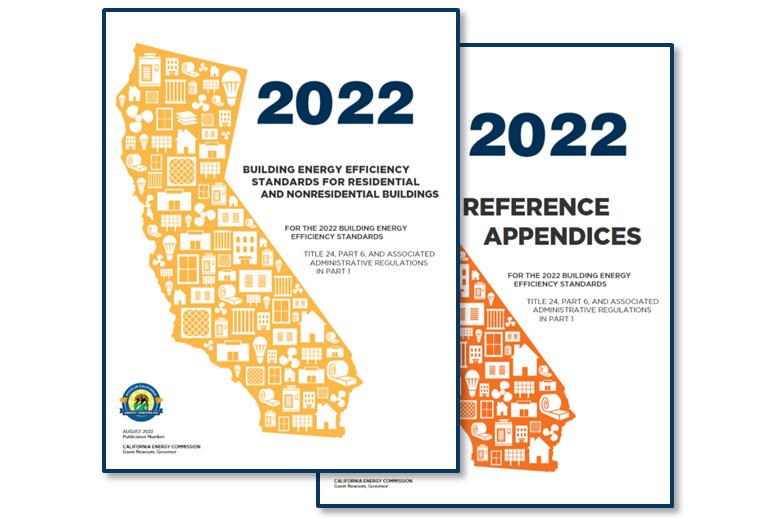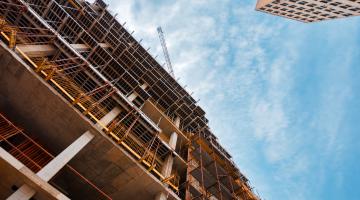
2022 Energy Code for Residential and Nonresidential Buildings
Reference Appendices
2022 Energy Code: Reference Appendices are adopted along with the Energy Code and contain data and other information that helps builders comply with the standards. The Reference Appendices includes sections on weather data, performance of assemblies with insulation, and residential and nonresidential tests and procedures.
Compliance Manuals
These documents, a part of the energy conservation manual, are designed to help the building industry comply with and regulators enforce the 2022 Energy Code for residential, nonresidential, and multifamily buildings. They are written as a reference and an instructional guide and can be helpful for anyone that is directly or indirectly involved in design and construction.
- 2022 Single-Family Residential Compliance Manual
- 2022 Nonresidential and Multifamily Compliance Manual
Compliance Documents - Forms
- Single-Family Residential Forms
- Low-rise Multifamily Forms
- Nonresidential, Hotel/Motel, High-rise Multifamily Forms
Impact Analysis
Compliance Software
CEC approved software to demonstrate performance compliance with residential and nonresidential provisions of the 2022 Energy Code. Performance modeling allows a user to assess building system performance or different building components against the Energy Code baseline.
Alternative Calculation Method (ACM) Manuals
These manuals identify the modeling rules used within the compliance software.
- 2022 ACM Approval Manual
- 2022 Single-Family Residential ACM Reference Manual
- 2022 Nonresidential and Multifamily ACM Reference Manual
Data Registry Requirements Manual
This manual is intended to aid in designing and implementing software procedures and user interface features. As a resource for data registry providers, it includes information and explanations regarding the functional and technical aspects of the requirements given in Reference Joint Appendix JA7.
Tools
- Solar Assessment Tools
Builders must verify and document the shading conditions of a building’s installed solar photovoltaic (PV) system by using the CEC-approved solar assessment tool.
- Climate Zone Tool
This tool helps to show addresses and locations quickly and accurately in relation to the geographic metes and bounds that determine California’s climate regions. Search by climate zone or zip code.
- Special Cases for Building Energy Efficiency Standards
Information about calculation methods and measures that cannot be properly accounted for in the approved compliance approaches.
- Manufacturer Certification for Building Equipment
Manufacturers certify to the CEC that the building equipment, products, and devices listed meet the applicable Energy Code requirements.
- Acceptance Test Technician Certification Provider Program - ATTCP
The program ensures that lighting control and mechanical contractors comply with the Energy Code in nonresidential buildings. - Home Energy Rating System Program - HERS
The program addresses construction defects and poor equipment installation, including HVAC systems and insulation, by evaluating homes.
Final Rulemaking Documents for the 2022 Energy Code (Title 24, Parts 1 and 6)
- Initial Statement of Reasons (ISOR)
- Final Statement of Reasons (FSOR)
- Response to Comments
- Updated Informative Digest
- Nine Point Criteria
Final Rulemaking Documents for CALGreen (Title 24, Parts 2-5 and 11)
- Final Express Terms
- Initial Statement of Reasons (ISOR)
- Final Statement of Reasons
- Response to Comments
- Updated Informative Digest
- Nine Point Criteria
All documents relating to a specific 2022 Energy Code rulemaking can be found within the linked dockets:
- 2022 Energy Code Photovoltaic and Battery Storage Cost-Effectiveness Determinations 22-BSTD-04
- 2022 Energy Code Compliance Software and Supporting Documents (Docket Log # 22-BSTD-02)
- 2022 Energy Code Part 6 Rulemaking (Docket Log # 21-BSTD-01)
- 2022 Energy Code Environmental Impact Report (Docket Log # 21-BSTD-02)
- 2022 Energy Code Parts 2-5 and 11 Rulemaking (Docket Log # 21-BSTD-03)
- 2022 Energy Code Compliance Manuals and Forms (Docket Log # 21-BSTD-04)
- 2022 Energy Code Pre-Rulemaking (Docket Log # 19-BSTD-03)
- 2022 Energy Code Compliance Metric (Docket Log # 19-BSTD-04)
Supporting Content

